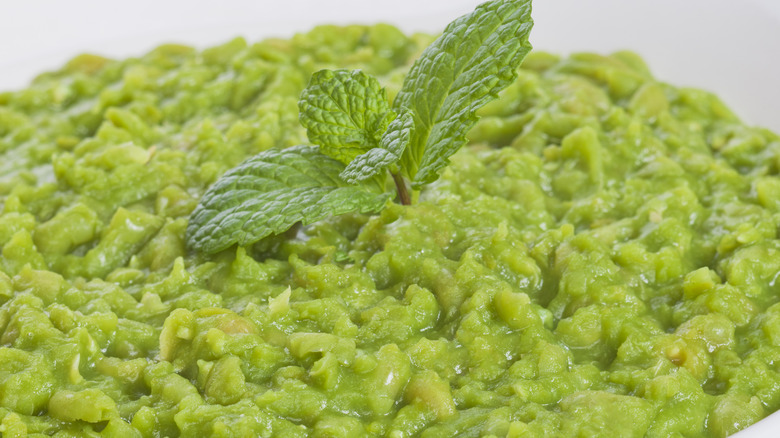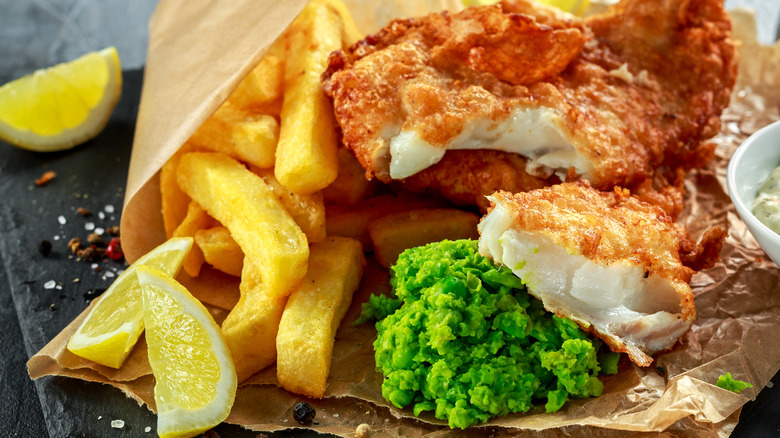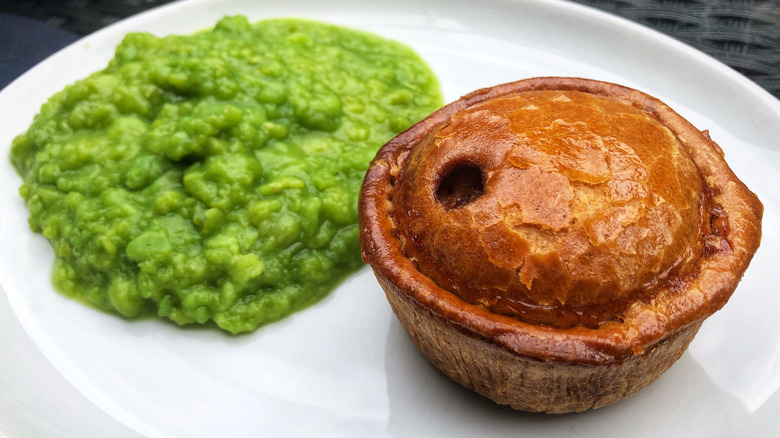What Exactly Are Mushy Peas?
Certain places are tied to specific foods. Even when these foods spread across the globe, they're tied to a place — like Japan's sushi, or Britain's fish and chips. In other cases, these foods don't travel well. For example, Australia and Vegemite. Or Cincinnati's goetta. They're beloved at home, but they don't translate very well unless you grew up smearing yeast extract onto toast — or had a slice of solidified pork and oat porridge fried to a crisp for breakfast.
Sometimes, those well-traveled and happily received foods forget a sidekick at home. In the case of fish and chips, that forgotten side dish is mushy peas. It's not clear why they didn't come along for the ride, but it seems pretty likely that they aren't going to be welcomed anytime soon. Maybe it's the name. Mushy isn't the most mouth-watering adjective. Or maybe it's the fact that they look like congealed pea soup. Either way, they've remained a foreign concept in spite of our embrace of fish and chips.
How could the undisputed champions of fish and chips be so wrong about how they eat one of their national dishes? Mushy peas deserve a closer look. Is ignoring mushy peas the biggest mistake you're making with homemade fish and chips?
Mushy peas are what you think, but that's not the whole story
Britain's fish and chip history is deep-rooted and goes back to immigrants to the country, but mushy peas are a relative newcomer. It's only been since the 1970s that mushy peas have been an assumed side. It's a rough puree of dried peas, but that doesn't mean that it's a vegetable side dish. It's more like a condiment, similar to how we might use tartar sauce.
After dried peas are soaked overnight, they're simmered till tender and then mashed. Soft, mushy peas create a crucial texture contrast to a meal that's built around being fried to a golden brown crisp. The back and forth between the two contrasts are exciting to our palate. Plus, mushy peas aren't as plain as you might think. They're well seasoned, and, just like the fish and chips, mushy peas get splashes of vinegar and tartar sauce while eating.
Peas are a pulse. Just like other pulses, like white beans, or chickpeas, they're inexpensive, nutritious, and perfect for turning into a spread or dip. Chickpeas are the basis of creamy homemade hummus, white beans can be whipped into a cannellini bean dip, and peas can be turned into mushy peas. "Seared Scallops with Pea Puree" is hardly different than "Seared Scallops with Mushy Peas." Maybe mushy peas aren't so strange after all.
Give mushy peas a chance
The fresh pea puree with those scallops is a version of mushy peas, but the type found in a fish and chip shop will probably be made from dried peas. Marrowfat peas, to be specific. Unlike the more common dried split peas, which are harvested earlier, marrowfat peas are left in the field to fully ripen and dry. The result is a large, round pea that isn't common in American supermarkets, but you probably recognize them in wasabi peas. Any whole dried pea will work, but legit marrowfat peas are available from certain sellers, like Amazon.
Traditional mushy peas start by giving marrowfat peas an overnight soak in a brine of baking soda that will help them to soften. After thorough rinsing, they're simmered till tender, mashed — or pureed — with a bit of butter, and seasoned with lemon, or sometimes fresh mint. These mushy peas can be served along with meat pies, salmon fishcakes, or bangers and mash in addition to fish and chips.
A more modern take can be made with frozen or freshly cooked peas. These pushy peas will have a vibrant green color, as opposed to the darker green versions made from dried peas. These types won't mush as easily, so a food processor is the best tool for the job. Breaking from tradition means you can use some extra-virgin olive oil for the butter — or use some tangy Greek yogurt.


